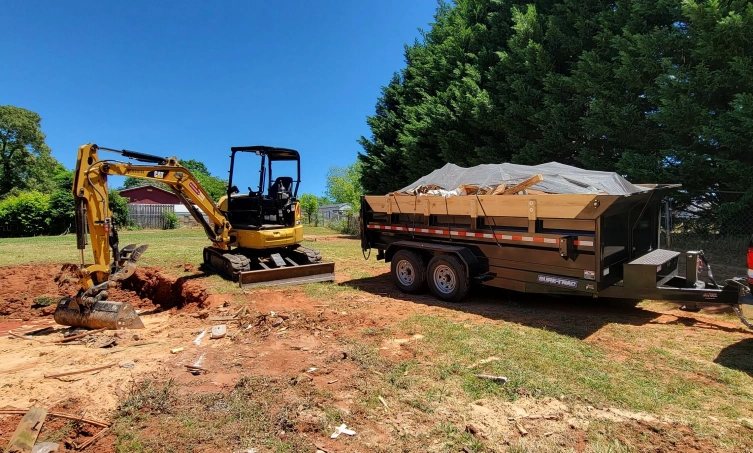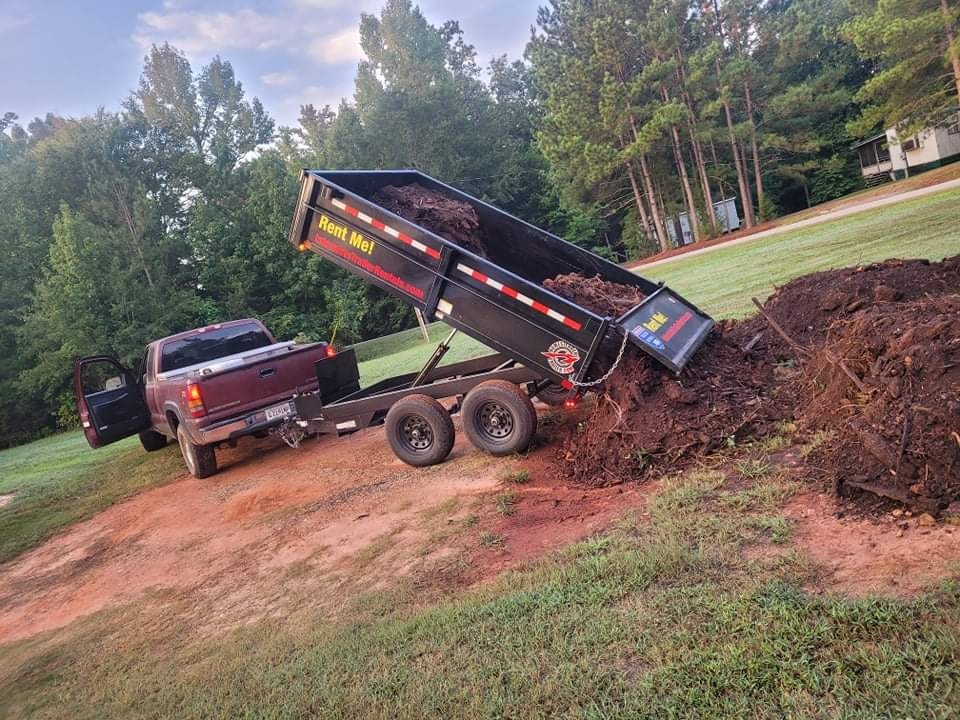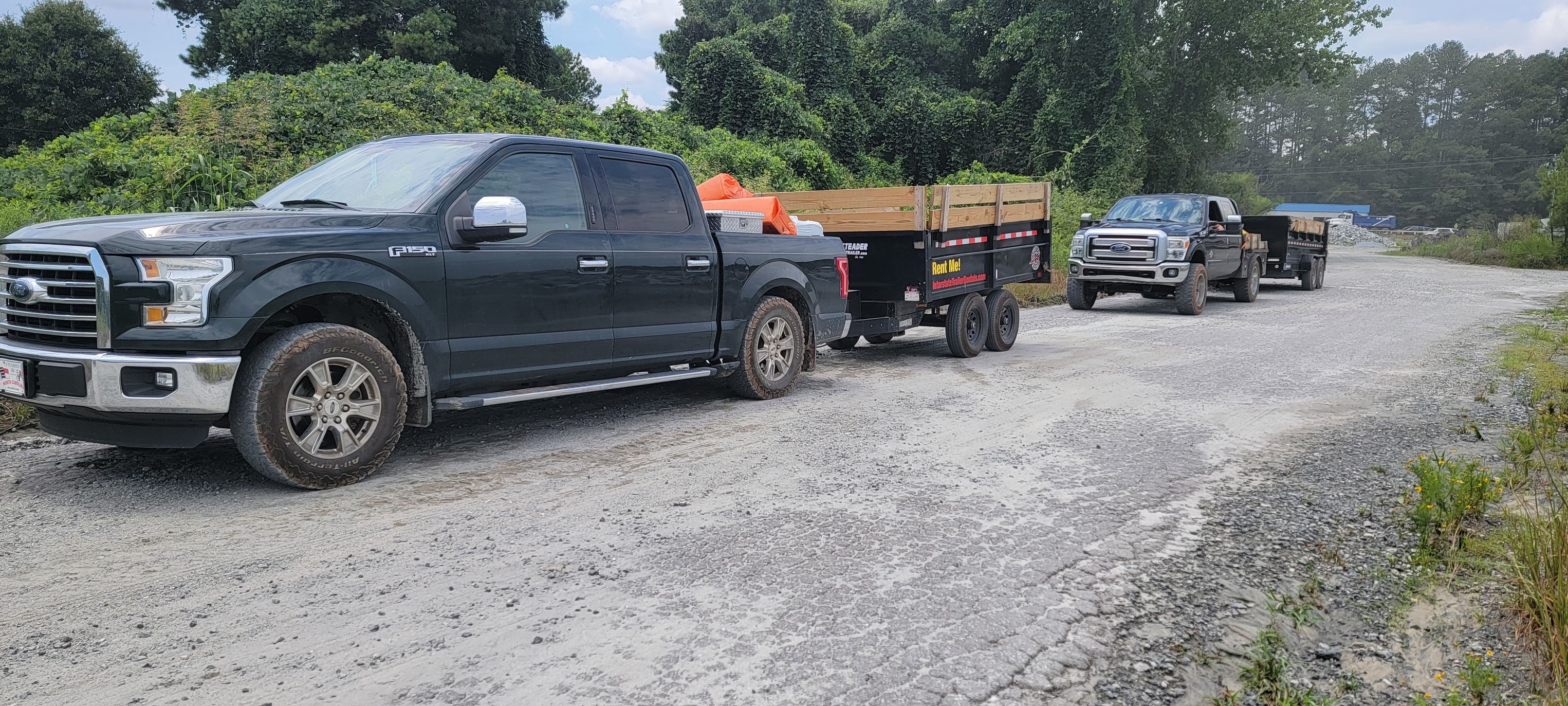
Dump Trailers and Tow Vehicles: A Practical Guide
Dump trailers are built to move weight, not just “whatever fits in the box.” Matching the right dump trailer to the right tow vehicle is critical for safety, avoiding tickets, and not destroying your truck or trailer in the process.
This guide walks through common dump trailer sizes, what they’re best used for, which tow vehicles typically fit each size, and how to avoid the classic mistake of filling a 12–14 ft dump trailer to the brim with stone or concrete. You’ll also see how to calculate and mark a “max fill line” inside the trailer for heavy materials, including if you’ve added extra wood sides.
How Dump Trailers Are Sized (and Why GVWR Matters)
Dump trailers are usually described by the length of the box: 6 ft, 8 ft, 10 ft, 12 ft, 14 ft, and so on. Width is commonly 5–7 ft, and side heights range from about 18" up to 48" on high-side models.
The number that really matters is the Gross Vehicle Weight Rating (GVWR). This is the maximum allowed weight of the trailer and everything in it. To find how much you can actually haul, you use a simple formula:
Payload capacity = GVWR – empty (curb) weight of the trailer
All of the examples below assume you’re staying within payload, axle ratings, hitch ratings, and your truck’s tow rating. Always check the actual stickers and the owner’s manual for your specific truck and trailer.

Matching Trailer Size to the Job and Tow Vehicle
6–8 ft Single-Axle Dump Trailers – SUVs and Light Trucks
Smaller dump trailers in the 6–8 ft range are often 5×8 ft or 6×8 ft with a single 3,500–5,000 lb axle. They might weigh around 1,000–1,400 lb empty and carry 2,000–3,000 lb of payload.
- Typical tow vehicles: Midsize or full-size SUV, light-duty half-ton truck with a proper tow package.
- Best uses (generally < 12 ft):
- Mulch and compost for small landscaping projects.
- Leaves, brush, and yard cleanups.
- Garage and shed cleanouts with light household junk.
- Why they’re forgiving: The volume is small enough that it’s hard to overload with light material, but you still need to be careful with soil, stone, or concrete.
A small single-axle dump can typically be filled to the top with mulch or brush. For dense materials like gravel or wet soil, it’s usually safer to only fill ¼–½ of the side height and let the trailer – and your truck – live to haul another day.
10–12 ft Tandem-Axle Dump Trailers – The Half-Ton Sweet Spot
Stepping up to 10–12 ft usually means tandem axles. Common setups are dual 3,500 lb axles (GVWR around 7,000–8,000 lb) or dual 5,000 lb axles (GVWR around 10,000 lb). Empty weights run 2,000–3,000 lb, leaving 4,000–6,000 lb of payload.
- Typical tow vehicles: Properly equipped half-ton trucks (F-150, Ram 1500, Silverado 1500, etc.). Heavier loads are much happier behind a ¾-ton, but a well-spec’d half-ton can handle many jobs.
- Best uses (10–12 ft):
- Small to medium landscaping projects (several yards of mulch, topsoil, or stone).
- Bathroom and kitchen remodel debris.
- Roof tear-offs and shingle disposal.
- Small equipment like mowers, small compact tractors, or mini skid steers.
A 6×12 ft dump with 24" sides holds about 6 cubic yards by volume. With mulch, that’s fine. With stone or concrete, that’s a recipe for an overloaded trailer if you fill it to the top.
14+ ft Heavy-Duty Dumps – ¾-Ton and 1-Ton Trucks Only
Once you hit 14 ft and longer, most dump trailers step into the “heavy” category: tandem 7,000 lb axles (14,000 lb GVWR) or even 8,000 lb axles (16,000 lb GVWR). Empty weights in this class are often 4,000–5,000 lb, leaving roughly 9,000–10,000 lb of payload.
- Typical tow vehicles: ¾-ton and 1-ton pickups (F-250/F-350, Silverado/Sierra 2500–3500, Ram 2500–3500) with integrated brake controllers and heavy-duty tow packages.
- Best uses (12+ ft, especially 14–16 ft):
- Whole-house or estate cleanouts.
- Commercial roofing jobs and heavy demolition debris.
- Hauling compact equipment plus attachments.
- Larger landscaping jobs with multiple yards of material.
These trailers can feel “empty” even when they’re near their weight limit because the box volume is so large. A 14–16 ft dump can easily fit 10+ tons of stone by volume while only being rated to safely carry about 5 tons of payload.
Also remember: once your truck and trailer’s combined GVWR crosses 26,000 lb and/or the trailer GVWR exceeds 10,000 lb, CDL and commercial rules can apply. For a deeper dive into the legal and liability side, check out The Legal Side of Towing: Protecting Your Trailer Rental Business and Avoiding Costly Mistakes .

Material Weights: Why Volume Lies and the Scale Doesn’t
Bulk materials have very different densities. A trailer that can swallow a huge pile of mulch without breaking a sweat can be dangerously overloaded with just a shallow layer of stone or concrete. Here are rough weights per cubic yard to plan by:
| Material | Approx. lbs per cubic yard | Approx. tons per cubic yard | Notes |
|---|---|---|---|
| Mulch / wood chips | 400–800 lb | 0.2–0.4 ton | Light; most trailers are volume-limited, not weight-limited. |
| Leaves & brush (loose) | 250–400 lb | 0.1–0.2 ton | Bulky but very light, especially when dry. |
| Compost | 1,000–1,600 lb | 0.5–0.8 ton | Moisture content makes a big difference. |
| Soil / topsoil (loose) | 2,000–3,000 lb | 1.0–1.5 ton | Wet or compacted soil jumps to the high end quickly. |
| Sand | 2,700–3,300 lb | 1.3–1.65 ton | Dry sand is lighter; saturated sand is very heavy. |
| Crushed stone / gravel | 2,600–2,800 lb | 1.3–1.4 ton | One of the easiest ways to overload a dump trailer. |
| Rip-rap / large rock | Up to ~4,000 lb | ≈2.0 ton | Very dense; shallow layers only. |
| Concrete / asphalt rubble | 2,000–4,000+ lb | 1–2 ton | Broken concrete with air gaps is lighter than solid, but still heavy. |
| Roofing shingles | 2,400–4,000+ lb | 1.2–2+ ton | One “square” (100 sq ft) is often 250–360 lb; multiple layers add up fast. |
| General household junk | 150–400 lb | 0.075–0.2 ton | Volume usually maxes out before weight does. |
As a rough rule, 1 cubic yard = 27 cubic feet, and to go from cubic yards to tons you can estimate:
tons ≈ (lbs per cubic yard ÷ 2,000)
Why a 12–14 ft Dump Trailer Can Hold 10 Tons of Stone but Only Haul About 5
Let’s take a common “big” dump trailer: 14 ft long, 7 ft wide, 24" (2 ft) sides, 14,000 lb GVWR.
- Box volume: 14 ft × 7 ft × 2 ft = 196 ft³ ≈ 7.3 cubic yards.
- Crushed stone at ~2,700 lb/yd³: 7.3 × 2,700 ≈ 19,700 lb of stone.
Meanwhile, the trailer might weigh about 5,000 lb empty. That leaves:
Payload = 14,000 lb GVWR – 5,000 lb empty = 9,000 lb usable payload
So the trailer can physically hold almost 10 tons of stone by volume, but is only rated to carry about 4.5–5 tons by weight. If you blindly “fill it to the top,” you’re more than double the rated payload before you even leave the driveway.
That’s where a calculated max fill line becomes your best friend.
Is ~11" Really the Right Max Fill Line for Stone? (Yes – Here’s the Math)
Using the same 14 ft × 7 ft dump trailer with 14,000 lb GVWR and 5,000 lb empty weight:
- Payload = 9,000 lb (as above).
- Convert stone density to pounds per cubic foot:
2,700 lb/yd³ ÷ 27 ft³/yd³ ≈ 100 lb/ft³. - Find the floor area of the trailer: 14 ft × 7 ft = 98 ft².
- How many cubic feet of stone can you haul?
9,000 lb ÷ 100 lb/ft³ = 90 ft³. - Convert volume to height: 90 ft³ ÷ 98 ft² ≈ 0.92 ft.
0.92 ft × 12 in/ft ≈ 11 inches.
So yes, for this specific trailer and that density, around 11 inches of stone across the floor is the realistic max fill height for stone. That’s about halfway up a standard 24" steel side.
If your stone is wet or particularly dense, you’d want to be even more conservative (think more like 9–10" instead of a full 11"). But as a clearly visible rule of thumb, that 10–11" stripe tells you “this is where we stop with rock.”
How to Mark a Max Fill Line Inside Your Dump Trailer
You can apply the same logic to any trailer and any material. Here’s a simple step-by-step:
- Find your numbers:
- Trailer GVWR (from the sticker).
- Trailer empty weight.
- Inside bed length and width.
- Estimated material density in lb per cubic yard.
- Calculate payload:
Payload = GVWR – empty weight. - Convert density:
lbs per ft³ = (lbs per yd³ ÷ 27). - Find allowed volume:
Allowed ft³ = Payload ÷ (lbs per ft³). - Get your max height:
Max height (ft) = Allowed ft³ ÷ (length × width). - Convert to inches:
Max height (in) = Max height (ft) × 12.
Once you have that height:
- Measure up from the floor (for example, 11").
- Mark that point in several spots along each wall.
- Snap a chalk line or tape off a stripe.
- Paint a bold red line inside the trailer at that height.
From then on, everyone loading stone, concrete, or shingles has a clear visual reminder: do not load dense materials above this line. You’ll still have plenty of capacity for bulky and lighter material above it when needed.
What If I Add Wood Sides or Build Taller Walls?
Many owners build extra sides on their dump trailers using 2×6 or 2×8 boards. For example, you might stack two 2×6 boards horizontally on a 10 ft dump, leaving a small gap between the boards. This gives you:
- More height for light, bulky material like brush, junk, or cleanout debris.
- A built-in “overflow” pattern where stone or soil starts spilling out of the gaps instead of being piled 3 ft over the factory sides.
Here’s the key: adding wood sides does not change your trailer’s GVWR, axle rating, or payload. It only changes how much volume you can stack in there. For heavy materials:
- Keep your weight-based fill line referenced from the original steel side height, not the top of your added boards.
- Think of everything above the red line as “light material only” space: junk, bags, brush, boxes, etc.
- If you intentionally leave small gaps between boards, that’s a nice fail-safe: once stone or soil starts leaking through, you’ve probably reached your safe weight limit anyway.
On your own 10 ft trailer, building sides out of two 2×6’s with gaps works exactly this way: heavy loads naturally level out below the top board, but you can still pile bulky items higher without pushing the trailer dangerously overweight.
Putting It All Together: Size, Use, and Tow Vehicle at a Glance
| Dump Trailer Size | Typical Jobs | Common Tow Vehicle | Weight Tips |
|---|---|---|---|
| 6–8 ft single axle (3.5K–7K GVWR) |
Small landscaping, yard waste, light cleanouts. | Midsize SUV or light half-ton with tow package. | Full with mulch is usually fine; only partial height with stone or soil. |
| 10–12 ft tandem axle (~7K–10K GVWR) |
Remodel debris, small roofing jobs, several yards of material, compact equipment. | Well-equipped half-ton; ¾-ton preferred for heavier loads. | Don’t fill to the top with stone or concrete; calculate a max fill line. |
| 14–16+ ft heavy-duty (14K+ GVWR) |
Large cleanouts, commercial roofing, demolition, equipment hauling. | ¾-ton or 1-ton truck, often with CDL considerations depending on use. | Trailer can physically hold ~10 tons of stone but is only rated for ~5; always load by weight, not by “looks.” |
Final Thoughts: Load by the Numbers, Not by the Pile
Dump trailers are incredibly useful tools for homeowners, landlords, and contractors. Smaller, under-12 ft trailers pair well with SUVs and lighter trucks for mulch, brush, and cleanouts. Mid-size 10–12 ft tandem dumps are the workhorses that match nicely with half-ton pickups when used within their ratings. The big 14–16 ft, 14,000+ lb trailers really belong behind ¾-ton and 1-ton trucks and should be treated like the heavy equipment they are.
If you remember nothing else, remember this: heavy materials are limited by weight, not by how empty the trailer looks. Use a calculated max fill line, keep an eye on material densities, and make sure your tow vehicle is truly up to the job.
For more on staying compliant, avoiding tickets, and protecting your business, read The Legal Side of Towing: Protecting Your Trailer Rental Business and Avoiding Costly Mistakes . Pairing that legal knowledge with the sizing and loading tips in this article will keep your trailers – and your customers – on the road and out of trouble.

